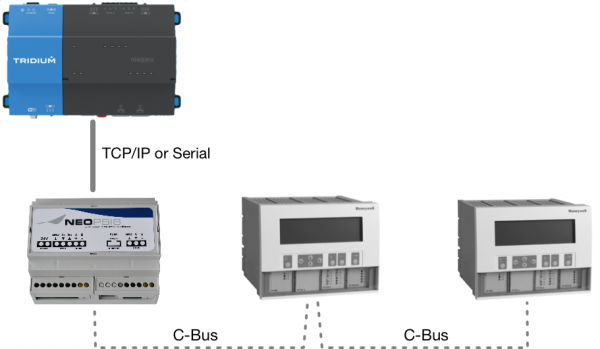C-Bus Connectivity Kit
Architecture
The Niagara driver does not communicate directly with the C-Bus; it uses a piece of hardware called Intelligent External Converter (IEC). This converter acts on the C-Bus as a standard XL5000 controller. It must have a unique name and address. The converter maintains its database of all C-Bus data points monitored by the driver and maintains a cache for data and commands. One IEC can connect with up to 29 XL5000 controllers (IEC itself needs one C-Bus address) and can control up to 3000 data points. You can combine multiple IEC's connected to one C-Bus where each IEC maintains a unique set of data points. The real maximal installation size depends on the Niagara station resources and application characteristics.
The communication between the Niagara driver and the IEC is implemented either over a serial line or a TCP/IP network. The communication protocol is proprietary. The driver interprets this protocol and maps the IEC internal data structures and events into the Niagara objects.

The IEC manages bus communication and caches the message requests and responses. The key component of the driver - the IEC Monitor - polls the IEC for data with high frequency, typically 1 second and imports the data into the Niagara framework. The C-Bus Communication Kit takes advantage of the Niagara subscribe and unsubscribe mechanism. If any data point is subscribed in the Niagara framework, the data point in the XL5000 controller is set into the refresh mode and starts to report values by exception. When the data point is unsubscribed in the Niagara driver, the point in the XL5000 controller is removed from refresh mode and stops to report by exception.
If CoV mode is not possible or acceptable for some reason, the driver uses the Niagara polling mechanism to communicate with Excel controllers. Even in this mode, only points that are subscribed in the Niagara Framework are questioned. Mixed mode is also supported, with some of the data points running in polling mode and the other reporting the exception values. This allows fine-tuning of the C-Bus.
